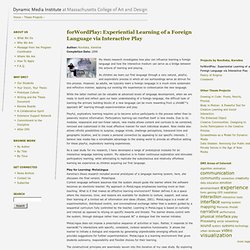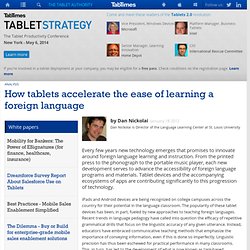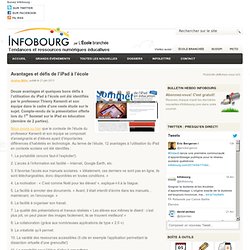

ForWordPlay: Experiential Learning of a Foreign Language via Interactive Play. My thesis research investigates how play can influence learning a foreign language and how the interactive medium can serve as a bridge between the actions of learning and playing.

As children we learn our first language through a very natural, playful, and exploratory process in which all our surroundings serve as stimuli for this process. However, as adults, we typically learn a foreign language in a much more systematic and reflective manner, applying our existing life experiences to contextualize the new language. While the latter method can be valuable at advanced levels of language development, when we are ready to build and reflect upon our basic understanding of a foreign language, the difficult task of learning the primary building blocks of a new language can be more rewarding from a child’s approach – learning through experimentation and play.
As a case study for my research, I have developed a range of prototypical modules for an interactive language learning system. Hacking Language Learning: Benny Lewis at TEDxWarsaw. Leading From The Heart » Learning, Naturally. …or is that Acquiring, Naturally?

I’ve been thinking a lot about language learning lately, as I bring a group of students towards final evaluations in a few weeks’ time. This group is small, though of the 9 students there are 6 different levels I need to evaluate. So, I repeat, I’ve been thinking a lot about language learning lately :) A few lines from Mr. Krashen: “Language acquisition does not require extensive use of conscious grammatical rules, and does not require tedious drill.” ” Acquisition requires meaningful interaction in the target language – natural communication – in which speakers are concerned not with the form of their utterances but with the messages they are conveying and understanding.” ” The best methods are therefore those that supply ‘comprehensible input’ in low anxiety situations, containing messages that students really want to hear.
Do I like what he says because this is how I ultimately end up teaching? v17n1.pdf. L'émergence des classes d'apprentissage actif au collégial. Microsoft Word - Pedagogie Active.doc - Pedagogie-Active.pdf. Narrate Slideshows With 30hands for iPad. 30hands is a free iPad app that makes it very easy to create a narrated slideshow.

To create a basic narrated slideshow on 30hands all you need to do is import images from your iPad’s camera roll then press the record button below each image to record your narration. If you don’t have any pictures on your iPad you can take pictures using the 30hands app. 30hands also allows you to draw images instead of importing pictures. You can combine imported pictures with drawn images in your presentations. And you can draw on top of imported images. When your project is complete you can save it on your iPad or share it with the 30hands community. Students do not need to register on 30hands in order to use the app. Tags: digital storytelling, free ipad app, slideshows, video creation. How tablets accelerate the ease of learning a foreign language. iPads and Android devices are being recognized on college campuses across the country for their potential in the language classroom.

The popularity of these tablet devices has been, in part, fueled by new approaches to teaching foreign languages. Recent trends in language pedagogy have called into question the efficacy of repetitive grammatical drills that focus on the linguistic accuracy of any given utterance. Instead, educators have embraced communicative teaching methods that emphasize the importance of conveying information, even if this is done so imperfectly. Linguistic precision has thus been eschewed for practical performance in many classrooms. This, in turn, has led to the development of what is now known as task-based instruction.
Communicative teaching methods are complimented and enhanced by technology that is primarily task-based, such as the various applications found on mobile devices. Capitalizing on apps for language learning 1. 3. Avantages et défis de l’iPad à l’école. Douze avantages et quelques bons défis à l’utilisation du iPad à l’école ont été identifiés par le professeur Thierry Karsenti et son équipe dans le cadre d’une vaste étude sur le sujet.

Compte-rendu de la présentation offerte lors du 1er Sommet sur le iPad en éducation (dernière de 2 parties). Nous avons vu hier que le contexte de l’étude du professeur Karsenti et son équipe se composait d’enseignants et d’élèves ayant d’importantes différences d’habiletés en technologie. Au terme de l’étude, 12 avantages à l’utilisation du iPad en contexte scolaire ont été identifiés : 1. La portabilité (encore faut-il l’exploiter!) 2. 3. 4. 5. 6. 7.